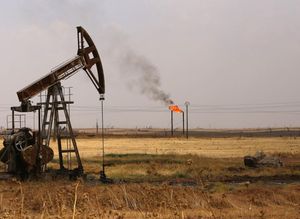A forthcoming White House proposal to put a $10 per barrel fee on oil essentially amounts to a partial tax on carbon.
Over the next decade, that fee, to be paid by oil companies, would fund $300 billion of investments in mass transit, high-speed rail, self-driving vehicles and other forms of transportation that reduce dependence carbon, according to Politico.
It's long overdue.
Companies currently spew carbon emissions into the atmosphere with impunity. Those emissions, largely in the form of carbon dioxide, serve as greenhouse gases that warm the planet and have begun to drastically alter the climate. Without severe intervention by business leaders and governments, the planet is expected to warm by more than 2 degrees Celsius above pre-industrial temperatures. At that point, human civilization -- particularly that which is situated along coastlines -- will be in jeopardy or, to be frank, underwater.
One long-proposed solution has been to put a tax on carbon, thereby financially incentivizing polluters to emit less and ultimately wean off fossil fuels.
According to the World Bank, which made the animation above, there are two main types of carbon taxes:
An [Emissions Trading Systems] – sometimes referred to as a cap-and-trade system – caps the total level of greenhouse gas emissions and allows those industries with low emissions to sell their extra allowances to larger emitters. By creating supply and demand for emissions allowances, an ETS establishes a market price for greenhouse gas emissions. The cap helps ensure that the required emission reductions will take place to keep the emitters (in aggregate) within their pre-allocated carbon budget.
A carbon tax directly sets a price on carbon by defining a tax rate on greenhouse gas emissions or – more commonly – on the carbon content of fossil fuels. It is different from an ETS in that the emission reduction outcome of a carbon tax is not pre-defined but the carbon price is.
President Obama's proposal, expected to be made public next week, could provide a third possible option.
Original Article
Source: huffingtonpost.com/
Author: Alexander C. Kaufman
Over the next decade, that fee, to be paid by oil companies, would fund $300 billion of investments in mass transit, high-speed rail, self-driving vehicles and other forms of transportation that reduce dependence carbon, according to Politico.
It's long overdue.
Companies currently spew carbon emissions into the atmosphere with impunity. Those emissions, largely in the form of carbon dioxide, serve as greenhouse gases that warm the planet and have begun to drastically alter the climate. Without severe intervention by business leaders and governments, the planet is expected to warm by more than 2 degrees Celsius above pre-industrial temperatures. At that point, human civilization -- particularly that which is situated along coastlines -- will be in jeopardy or, to be frank, underwater.
One long-proposed solution has been to put a tax on carbon, thereby financially incentivizing polluters to emit less and ultimately wean off fossil fuels.
According to the World Bank, which made the animation above, there are two main types of carbon taxes:
An [Emissions Trading Systems] – sometimes referred to as a cap-and-trade system – caps the total level of greenhouse gas emissions and allows those industries with low emissions to sell their extra allowances to larger emitters. By creating supply and demand for emissions allowances, an ETS establishes a market price for greenhouse gas emissions. The cap helps ensure that the required emission reductions will take place to keep the emitters (in aggregate) within their pre-allocated carbon budget.
A carbon tax directly sets a price on carbon by defining a tax rate on greenhouse gas emissions or – more commonly – on the carbon content of fossil fuels. It is different from an ETS in that the emission reduction outcome of a carbon tax is not pre-defined but the carbon price is.
President Obama's proposal, expected to be made public next week, could provide a third possible option.
Original Article
Source: huffingtonpost.com/
Author: Alexander C. Kaufman

No comments:
Post a Comment